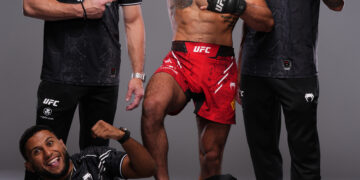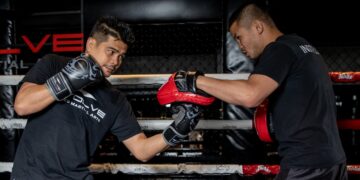
The pocket is one of the most dangerous distances in MMA. From the pocket, both fighters can unleash their entire arsenal of striking and grappling. Some of MMA’s most exciting moments come from exchanges in the pocket. Today, Evolve Daily is pleased to share five ways to elevate your striking in the pocket for MMA.
1) Hand Fighting
Hand Fighting occurs anytime you and your opponent’s hands or arms make contact, whether through striking or grappling.
Trapping, parrying, and pinning are elements of hand fighting that can help you land your punches without taking damage yourself.
Vasyl Lomachenko is a perfect fighter to study when it comes to trapping, parrying, and pinning. Combined with smooth, efficient footwork, Lomachenko is able to take angles on his opponent and strike them, all while staying out of his opponent’s line of fire. The video above showcases Lomachenko’s skill in his fight against Jason Sosa.
Notice how frequently Lomachenko uses hand fighting to control Sosa’s posture while he executes his signature footwork sequences. Training just a few of these techniques can give you a significant advantage over an opponent who has not trained to deal with them. Watch Coach Icy Mike of Hard2hurt explain and demonstrate the basics of hand fighting in MMA.
2) Distance Management
Distance management may be the most important concept for any combat sport. Your ability to manage distance directly correlates to your ability to enter and exit the pocket safely.
The concept of distance management can be tricky due to the variances in each fighter. Some fighters are taller for their weight class, while others are shorter. Taller fighters don’t necessarily have a longer reach, although it is often the case. Alexander Volkanovski is an example of a shorter fighter that has a very long reach compared to other fighters in his weight class.
To improve your distance management, you must first determine your fight strategy. If your goal is to enter the pocket and stay there for the entire fight, your distance management tactics will differ from those of a fighter who only enters the pocket to land combinations.
Head movement is another tool you can use to keep you safe while entering or exiting the pocket. Be especially careful not to slip too deeply as boxers do; the threat of kicks and knees makes it too much of a risk in MMA. Watch Cory “The Sandman” Sandhagen explain head movement to close distance in the video above.
3) Clinching
Learning how to clinch is a key part of an MMA fighter’s game. Clinching gives you control of your opponent’s posture when you are in close range, allowing you to land your strikes more effectively while staying safe from your opponent’s attacks.
Sensitivity and striking from the clinch is an art of its own – Roberto Duran was a master of it in his prime. Duran would gain a superior clinch position by driving his head into one side of his opponent’s collarbone.
Duran preferred to take an inside position, where his arms were inside of his opponents. This gave him full access to his opponent’s body and head from a position where his own head was hidden.
4) Footwork
Footwork within the pocket is another key element that dictates the pace of the fight. One mistake that many beginners make is moving too much with each step. Fighting is a game of inches and milliseconds; too large of a step may keep you safe, but also puts you out of position to follow up.
One way to prevent this bad habit is to drill it during shadowboxing with a partner, or with an object on the floor in front of you. You can use your partner’s lead foot as a gauge of distance – you want to be at a distance where you have time to react, yet close enough to land your own counters.
When practicing this with a partner, both of you must maintain proper form. Since this drill is mostly stationary, it is easy to overreach with your punches or become lazy with your defense.
Always ensure that both you and your partner take small steps, keeping your core engaged in your fighting stance. Doing this continually is taxing both physically and mentally, but will greatly increase your ability to stay focused during a fight.
While standing in front of your partner, take a small step laterally, in either direction. Your partner should step in sync with you, preventing you from taking an angle. Repeat this drill several times, until you have gone in a circle, then switch roles. Watch coach Icy Mike of hard2hurt go in-depth on footwork for the pocket in the video above.
5) Timing
The importance of timing in MMA cannot be overstated. Without timing, you will not be able to land meaningful strikes. Proper timing can be difficult to develop, but once you understand the concepts, you still need to adjust to each fighter’s speed.
Being able to time your jab is one of the most important foundational techniques across combat sports. Landing your jab while reading your opponent’s rhythm lets you form a game plan.
If your opponent is aggressive and pressures forwards, you can time your jab to land right before their lead foot hits the ground, as they step towards you.
When done correctly, your opponent will feel “stuck” and you will almost always land your jab. This is due to the precise timing of when you threw your jab.
Conversely, when pressuring your opponent, jab them until their weight is on their back foot. Just as their weight shifts to their back foot, they’ll be ‘stuck’ for a moment. This is your chance to land a clean and powerful strike. Watch Coach Trevor Wittman explain this concept in the video above.
Conclusion
Striking from the pocket is an art in itself, and we hope these tips help you in your training! Train hard and fight on!
You may also like:
How To Find And Develop Your Individual Fighting Style For MMA
Finding your fighting style for MMA can take many years to develop. Even experienced fighters are constantly adding new facets to their style to stay ahead of the competition. Your individual fight style should suit…
The front snap kick has been used in mixed martial arts (MMA) since its early days. Royce Gracie often peppered opponents with it to set on his takedowns on this way to winning three of…
Alex “Poatan” Pereira is one of the most dynamic and exciting fighters in the current era of mixed martial arts. Poatans’ meteoric rise can be attributed to his devastating knockout power and fan-friendly style. However,…
The lead switch kick is a highly versatile technique that fighters can utilize across multiple combat sports such as Muay Thai and Mixed Martial Arts. The lead switch kick is often your closest weapon to…
In any martial arts, like Mixed Martial Arts, Muay Thai, or Boxing. Shadowboxing is an underutilized tool that can benefit any fighter, regardless of age, gender, or skill level! Anyone can shadowbox; all you need…
You’ve probably heard some fighter’s corner yelling ‘pummel, pummel, pummel’ if you’re a fan of mixed martial arts fights. Pummeling is the motion grapplers make to secure underhooks in clinch positions, and it allows you…
Wrestling is the oldest form of martial art in the world. As we advance to the modern age, innovation around wrestling has allowed it to be played with different styles and rule sets, bringing all…
Whether you’re an athlete, bodybuilder, or someone dedicated to maintaining physical fitness, muscle recovery is a critical component of training. Without proper recovery, your muscles don’t have the opportunity to repair, rebuild, and strengthen after…
When training Muay Thai, increasing your kicking power comes down to two aspects – your technique and your physical ability. Many Nak Muays focus heavily on technique, and rightfully so, but often forget to pay…
If you’re often at KINEX Mall for a good ol’ round of boxing, Muay Thai, Brazilian Jiu-Jitsu, or mixed martial arts session at Evolve MMA, you might be wondering whether there are lovely places to…
The underhook is an aspect part of grappling in BJJ. It is a hold that gives a strategic advantage by enabling strong control over an opponent and, at the same time, a good spot for…
The pawing jab won’t bring a fight to an end, but it can be an effective tool that sets up other punches that could leave your opponent unable to continue boxing. Used by legendary boxers…



































